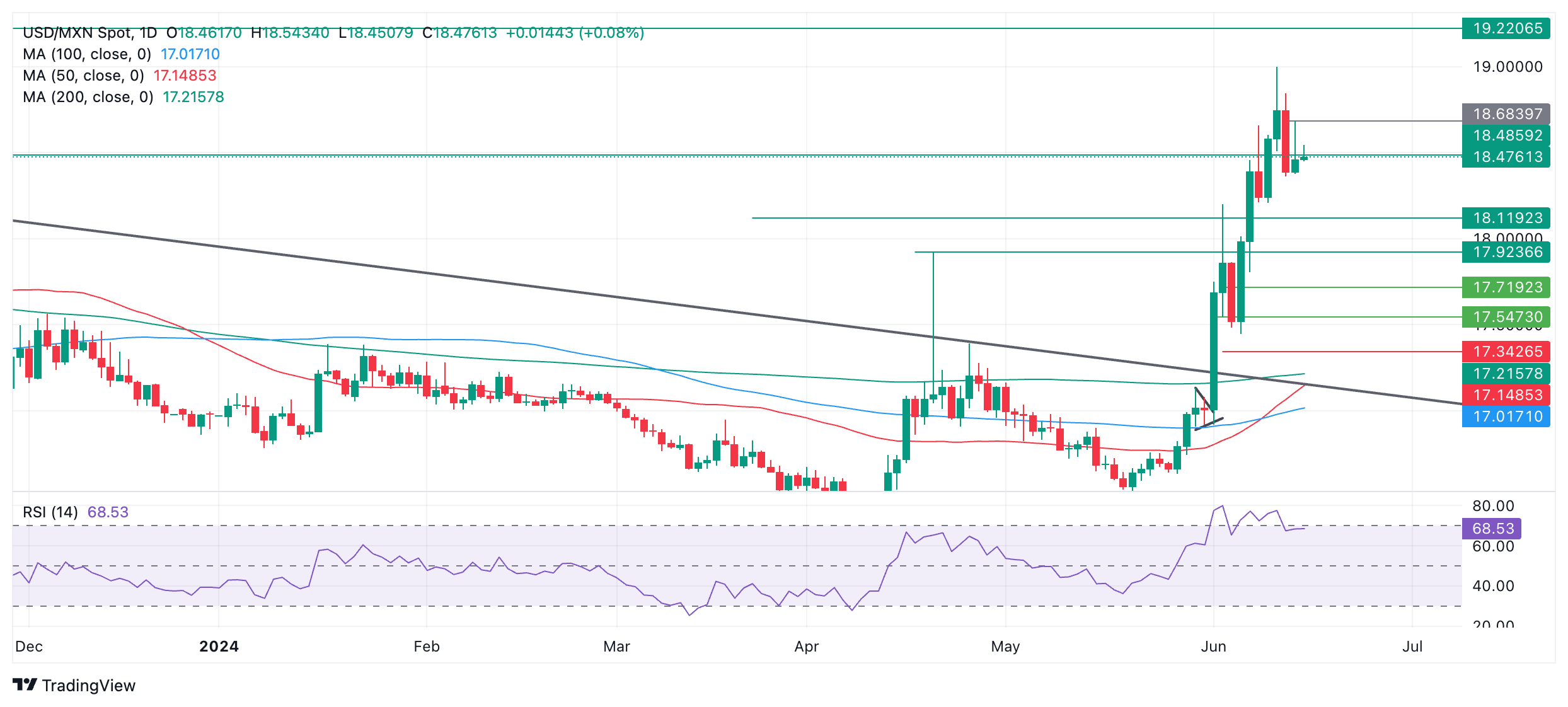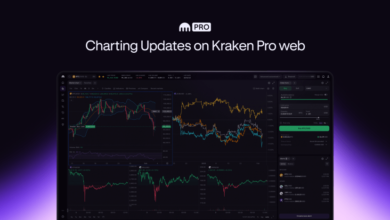Mexican Peso edges lower as risk-off sentiment weighs

- The Mexican Peso trades lower in its major pairs at the start of the new trading week.
- Global growth fears and the unwillingness of the Fed to lower borrowing costs are curbing enthusiasm and weighing on MXN.
- USD/MXN is still pulling back in the midst of a short and medium-term uptrend.
The Mexican Peso (MXN) edges lower in its key pairs on Monday as market sentiment sours amid global growth fears and French political uncertainty. As a “risk-on” currency, the Peso accordingly takes some heat.
At the time of writing, a single US Dollar (USD) buys 18.49 Mexican Pesos, EUR/MXN is trading at 19.81 and GBP/MXN at 23.44.
Mexican Peso edges lower on global outlook, Fed caution
The Mexican Peso trades marginally bearish at the start of the new trading week as global growth concerns and the political situation in France weigh. A contraction in official Chinese manufacturing data in May combined with a fall in commodity imports due to rising prices are partly to blame. However, the US Federal Reserve’s (Fed) cautious stance at its meeting on Wednesday, with the bank clearly not in a hurry to reduce borrowing costs, further weighed on overall market sentiment.
On Thursday the Peso recovered after verbal intervention by the President of the Banco de Mexico (Banxico), Victoria Rodriguez Ceja, who said Banxico would step in to prop up the Peso if volatility became too “extreme”.
Political risk also continues to provide a background risk for the Peso. Investors are fretting over the victory of President-elect Claudia Sheinbaum and her left-wing coalition Sigamos Haciendo Historia (SHH) at the June 2 elections. SHH won a supermajority in the Mexican House of Deputies and came two seats away in the Senate. This will give it a mandate to push through radical amendments to the constitution that have set markets on edge.
Market positioning has added fuel to sell-off following the build-up of an overweight long bet on the Mexican Peso since its long-term uptrend began in 2020. Relatively high interest rates of 11.00%, set by the Banxico to control inflation, have been a major draw for investors seeking returns. This is especially true of carry traders, for example, who borrow in currencies with low interest rates like the Japanese Yen (Apr circa 0.0% -0.1%) and invest in currencies like the Mexican Peso that offer higher returns (Apr circa 11.00%), pocketing the difference.
“Before the election, we’d been arguing for some time that the Peso appeared increasingly overvalued and was vulnerable to a sharp fall – the declines over the past couple of weeks have taken it within touching distance of our long-standing year-end forecast of 19.00 (USD/MXN),” said Jason Tuvey, Deputy Chief Emerging Markets Economist at Capital Economics, to FXStreet.
Technical Analysis: USD/MXN pulls back but remains in short-term uptrend
USD/MXN appears to be resuming its short-term uptrend after a pullback, and given “the trend is your friend,” the odds favor a continuation higher, probably to the next target situated at 19.22 (March 2023 high).
USD/MXN Daily Chart
A break above Friday’s high at 18.68 would provide additional confirmation of more upside towards the target at 19.22.
The Relative Strength Index (RSI) has just exited the overbought zone, which is a signal for traders to close their longs. This suggests a risk the correction could still go deeper. That said, the established uptrend is likely to resume eventually.
The direction of the long-term trend is in doubt after the break above the October 2023 high. Previous to that, it was down.
Economic Indicator
Fed Interest Rate Decision
The Federal Reserve (Fed) deliberates on monetary policy and makes a decision on interest rates at eight pre-scheduled meetings per year. It has two mandates: to keep inflation at 2%, and to maintain full employment. Its main tool for achieving this is by setting interest rates – both at which it lends to banks and banks lend to each other. If it decides to hike rates, the US Dollar (USD) tends to strengthen as it attracts more foreign capital inflows. If it cuts rates, it tends to weaken the USD as capital drains out to countries offering higher returns. If rates are left unchanged, attention turns to the tone of the Federal Open Market Committee (FOMC) statement, and whether it is hawkish (expectant of higher future interest rates), or dovish (expectant of lower future rates).
Last release: Wed Jun 12, 2024 18:00
Frequency: Irregular
Actual: 5.5%
Consensus: 5.5%
Previous: 5.5%
Source: Federal Reserve
Information on these pages contains forward-looking statements that involve risks and uncertainties. Markets and instruments profiled on this page are for informational purposes only and should not in any way come across as a recommendation to buy or sell in these assets. You should do your own thorough research before making any investment decisions. FXStreet does not in any way guarantee that this information is free from mistakes, errors, or material misstatements. It also does not guarantee that this information is of a timely nature. Investing in Open Markets involves a great deal of risk, including the loss of all or a portion of your investment, as well as emotional distress. All risks, losses and costs associated with investing, including total loss of principal, are your responsibility. The views and opinions expressed in this article are those of the authors and do not necessarily reflect the official policy or position of FXStreet nor its advertisers. The author will not be held responsible for information that is found at the end of links posted on this page.
If not otherwise explicitly mentioned in the body of the article, at the time of writing, the author has no position in any stock mentioned in this article and no business relationship with any company mentioned. The author has not received compensation for writing this article, other than from FXStreet.
FXStreet and the author do not provide personalized recommendations. The author makes no representations as to the accuracy, completeness, or suitability of this information. FXStreet and the author will not be liable for any errors, omissions or any losses, injuries or damages arising from this information and its display or use. Errors and omissions excepted.
The author and FXStreet are not registered investment advisors and nothing in this article is intended to be investment advice.




